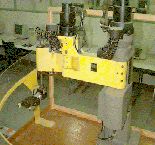Welcome to
the CSUN
CSMS Site!
CSMS LINKS
Main Index
Announcements
Defense Schedule
Introduction
General Information
Faculty Research
Forming a Committee
Writing a Proposal
FAQ
CAMPUS LINKS
CSUN Home
CSUN Library
CECS Home
CS Home
ACM/CSA
Dept. of Computer Science
California State Univ.
Northridge
18111 Nordhoff Street
Northridge, CA 91330
Phone (818) 677-3398
FAX (818) 677-7208
compsci@csun.edu
|
 |
There is actually no formal distinction between a thesis and a project.
Informally, however, a thesis is more of a research task while a project is more of an
applied task. Below I try to indicate the differences between a thesis
and a project. Following that, the general
form and content of a project or thesis proposal are described.
A thesis documents the process, the products, and the assimilation of an investigative
piece of work. The work should be in a current and advanced topic in computer science. It
is not enough to simply report on others' work. You must synthesize, elaborate on, and,
ideally, contribute to the body of knowledge you studied. Some example thesis topics:
"Performance comparisons of three string searching algorithms"
"An approximation algorithm with good performance guarantees for the traveling salesman problem with triangle inequality"
"The feasibility of a layered approach to software fault tolerance"
"Effectiveness of exception mechanisms for improving software reliability"
In many cases a thesis will involve developing a prototype (usually a program) to demonstrate the techniques and concepts under study. These prototypes are not expected to be "polished." The written report and defense will concentrate more on the techniques and ideas than the prototype implementation details.
A project generally involves a software implementation. Examples of project topics:
"A CAI package for teaching tree balancing techniques"
"A package for tracking the progress of students in the MS program"
"Software simulation of the N-Step RISC architecture"
"A program to play go on a 9 by 9 board"
The design and implementation of the software are expected to conform to current software engineering principles and practices. The written report should concentrate on the various design and implementation issues. Typically, there will be a design rationale including a discussion of the alternatives considered. The report should also include discussions on the methodology used (e.g., OOD or functional). The software is expected to be fully functional and of excellent quality, i.e., "polished." The defense will include a demonstration of the capabilities of the software.
0. COVER PAGE:
Declare whether a thesis or a project is being proposed and its title. Also, include
your name, your file number, your email address, the date, your committee chair, and a
place for your chair to sign indicating his approval of the proposal.
1. OBJECTIVE:
A short statement describing the primary objective of the proposed work. Shoot for no
more than five sentences.
2. INTRODUCTION:
Introduce the reader to the area in which you will be working. This includes basic
definitions and explanations geared toward an intelligent undergraduate computer science
student who has never been exposed to your area of work. Proceed to describe what sort of
work has already been done and exactly what you propose to do, going into as much detail
as possible. Indicate the technical importance and/or interest of your proposed work. In
discussing previous work you should cite references gathered in a literature search
including critiques and summaries of the references read and cited.
3. TECHNICAL APPROACH:
Describe your approach to your work. For example, describe any special machinery you
will be using, the design methods you plan to employ, insights you have into potential new
algorithms, etc. Produce a work breakdown structure, listing the major tasks and sub-tasks
of the proposed project or thesis.
4. SCHEDULE:
Provide a Gantt chart or similar device showing the start and completion dates of the
tasks and sub-tasks described in the work breakdown structure.
5. CRITERIA FOR SUCCESS:
Establish a set of criteria that can be used to evaluate the degree of success of your
proposed work. For example, how much faster will your new algorithm be than existing
algorithms? What level of skill will your go playing program achieve? How
closely will your simulator model the item being simulated and how efficient will the
simulation be? It should be possible to make an objective evaluation of your
completed work using the criteria you set down.
6. REFERENCES:
A Master's proposal must contain a set of references covering the related work. Each
reference should be critiqued and summarized in the introduction.
![]() to top of page
to top of page
Last updated: November 15, 2003. |
